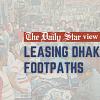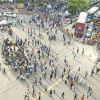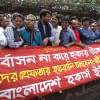Hawker eviction drive never works

The footpaths of Gulistan wear a vibrant look as hawkers line it with shops displaying attractive, colourful products. Pedestrians often stop to inspect the wares, leaving other passers-by to struggle to find space.
Dhaka South City Corporation’s (DSCC) claimed they had freed the footpath from hawkers two weeks ago.
The ground reality, however, was different.
During visits by these correspondents yesterday, a similar scenario was found in the Farmgate area, where street vendors had occupied the pavement despite being evicted around one and a half months ago, by Dhaka North City Corporation (DNCC).
The eviction drives are poorly planned as hawkers return, usually, hours after being removed, experts said. Hawker leaders also claim that about Tk 900 crore is extorted from them every year, allegedly by police, political influential and city corporation officials. This is also a reason why they can return so easily.
“In many cases, we reclaim a footpath in the morning, but they [hawkers] return to the same place in the evening,” a meeting source quoted DSCC Mayor Mohammad Sayeed Khokon as saying at the 13th board meeting of the Dhaka Transport Coordination Authority (DTCA) on Sunday.
During the previous board meeting held on June 19, a 12-member special committee was formed to free footpaths from grabbers, and identify and remove illegal vehicles from the streets within two months.
Khokon was made chief of the committee, while DNCC Mayor Md Atiqul Islam, the DMP commissioner, and chairpersons of BRTA, Rajuk, BRTC were made members.
Khandakar Rakibur Rahman, executive director of DTCA, submitted a report to the meeting, which said the DSCC had evicted illegal occupation on 32 spots and reclaimed 10.35 kilometre of footpaths till November 19.
It had also made about 29.65 km footpath useable for pedestrians.
The eviction drive was carried out largely in Gulistan, Paltan, Motijheel, Sadarghat, Eskaton, Jatrabari, New Market, Elephant Road and Khilgaon.
The DNCC too carried out such drives and freed about 16km long footpaths in Uttara, Gulshan, Khilkhet, Karwan Bazar, Mirpur, Mohakhali, Shyamoli and Agargaon areas.
The report also mentioned the places and dates of the drives.
According to the locations mentioned in the report, these correspondents yesterday visited Gulistan, Paltan, Motijheel, Farmgate, Green Road, Karwan Bazar and found many hawkers on the footpaths there.
The pedestrian’s suffering was yet to cease.
A source said that expressing frustration over the issue, the DSCC mayor told the meeting that the number of hawkers was rising and it seemed the whole city nowadays would turn into a market in the morning.
“It’s not possible to keep the footpath free of illegal occupation unless each of the police stations keep continuous monitoring in its areas,” the DSCC mayor was quoted as saying.
A source quoted Dhaka Metropolitan Police Commissioner Md Shafiqul Islam, who was present at the meeting, as saying that they did not have the necessary manpower and logistical support, like vehicles, for continuous monitoring of the footpaths.
The city has around 440kms of footpaths.
VESTED INTEREST, POOR PLANNING THE CAUSES
“What do we do? We’ve families to feed. The government promised us rehabilitation, but there is no progress in that,” a hawker, Sabuj, told these correspondents during their visit to Motijheel.
After Sunday’s meeting, Road Transport and Bridges Minister Obaidul Quader said both the city corporations would intensify their eviction drives, but he made no mention of the problems plaguing the drives or about the rehabilitation programmes.
In 2017, the DSCC had prepared a list of around 6,000 hawkers in different areas under its jurisdiction and allocated Tk 3 crore for their rehabilitation.
The work for it, however, has been going on at a snail’s pace, forcing the hawkers to return to the streets, the street vendors claimed.
Contacted, DSCC Chief Estate Officer Rasel Sabrin said he was new and unaware of the rehabilitation programme.
Rasel said they had fixed 10 designated spots in the capital -- such as in the Baitul Mukkaram mosque area, near Ideal School and College, Segunbagicha and Dilkusha -- for holiday markets. “But they [ the hawkers] are more interested in crowded places,” he added.
Urban designer Iqbal Habib blamed a lack of combined planning behind the messy situation.
He said occupied footpaths were a major reason behind traffic congestions, as pedestrians were often forced to use the main roads to avoid the crowded walkways.
He said more than 40 percent of the trips in the Dhaka city were between one and half kilometres, and if the footpaths could be kept free, then people would use those instead of commuting by road.
Iqbal said hawkers should be registered first and be rehabilitated on the free spaces beside footpaths.
But such planning was absent to serve vested interest, Iqbal alleged.
There are over 5 lakh hawkers in the country and each of them pays Tk 200 to Tk 250 every day to “linemen”, who serve as private agents of extortionists, said MA Kashem, president of Bangladesh Hawkers Federation.
“Though the government has recently launched a drive against extortionists, toll collection from hawkers is yet to be stopped,” he added.
Khandakar Rakibur Rahman, also a member secretary of the 12-member special committee formed to free footpaths, told The Daily Star, “There might have been some problems in the strategy. We could not involve all. We should change the strategy.”

 For all latest news, follow The Daily Star's Google News channel.
For all latest news, follow The Daily Star's Google News channel. 








Comments